[English] 日本語
 Yorodumi
Yorodumi- PDB-7l0b: Crystal structure of hydroxyacyl glutathione hydrolase (GloB) fro... -
+ Open data
Open data
- Basic information
Basic information
| Entry | Database: PDB / ID: 7l0b | ||||||||||||
|---|---|---|---|---|---|---|---|---|---|---|---|---|---|
| Title | Crystal structure of hydroxyacyl glutathione hydrolase (GloB) from Staphylococcus aureus, apoenzyme | ||||||||||||
 Components Components | Hydroxyacylglutathione hydrolase | ||||||||||||
 Keywords Keywords | HYDROLASE / GloB / esterase | ||||||||||||
| Function / homology |  Function and homology information Function and homology informationhydroxyacylglutathione hydrolase / hydroxyacylglutathione hydrolase activity / Hydrolases / hydrolase activity Similarity search - Function | ||||||||||||
| Biological species |  | ||||||||||||
| Method |  X-RAY DIFFRACTION / X-RAY DIFFRACTION /  SYNCHROTRON / SYNCHROTRON /  MOLECULAR REPLACEMENT / MOLECULAR REPLACEMENT /  molecular replacement / Resolution: 1.65 Å molecular replacement / Resolution: 1.65 Å | ||||||||||||
 Authors Authors | Miller, J.J. / Jez, J.M. / Odom John, A.R. | ||||||||||||
| Funding support |  United States, 3items United States, 3items
| ||||||||||||
 Citation Citation |  Journal: Elife / Year: 2021 Journal: Elife / Year: 2021Title: Structure-guided microbial targeting of antistaphylococcal prodrugs. Authors: Miller, J.J. / Shah, I.T. / Hatten, J. / Barekatain, Y. / Mueller, E.A. / Moustafa, A.M. / Edwards, R.L. / Dowd, C.S. / Planet, P.J. / Muller, F.L. / Jez, J.M. / Odom John, A.R. #1:  Journal: Biorxiv / Year: 2020 Journal: Biorxiv / Year: 2020Title: Structure-guided microbial targeting of antistaphylococcal prodrugs Authors: Miller, J.J. / Shah, I.T. / Hatten, J. / Barekatain, Y. / Mueller, E.A. / Moustafa, A.M. / Edwaards, R.L. / Dowd, C.S. / Planet, P.J. / Muller, F.L. / Jez, J.M. / Odom John, A.R. | ||||||||||||
| History |
|
- Structure visualization
Structure visualization
| Structure viewer | Molecule:  Molmil Molmil Jmol/JSmol Jmol/JSmol |
|---|
- Downloads & links
Downloads & links
- Download
Download
| PDBx/mmCIF format |  7l0b.cif.gz 7l0b.cif.gz | 333.2 KB | Display |  PDBx/mmCIF format PDBx/mmCIF format |
|---|---|---|---|---|
| PDB format |  pdb7l0b.ent.gz pdb7l0b.ent.gz | 272.5 KB | Display |  PDB format PDB format |
| PDBx/mmJSON format |  7l0b.json.gz 7l0b.json.gz | Tree view |  PDBx/mmJSON format PDBx/mmJSON format | |
| Others |  Other downloads Other downloads |
-Validation report
| Summary document |  7l0b_validation.pdf.gz 7l0b_validation.pdf.gz | 461.8 KB | Display |  wwPDB validaton report wwPDB validaton report |
|---|---|---|---|---|
| Full document |  7l0b_full_validation.pdf.gz 7l0b_full_validation.pdf.gz | 469.4 KB | Display | |
| Data in XML |  7l0b_validation.xml.gz 7l0b_validation.xml.gz | 34.6 KB | Display | |
| Data in CIF |  7l0b_validation.cif.gz 7l0b_validation.cif.gz | 48.7 KB | Display | |
| Arichive directory |  https://data.pdbj.org/pub/pdb/validation_reports/l0/7l0b https://data.pdbj.org/pub/pdb/validation_reports/l0/7l0b ftp://data.pdbj.org/pub/pdb/validation_reports/l0/7l0b ftp://data.pdbj.org/pub/pdb/validation_reports/l0/7l0b | HTTPS FTP |
-Related structure data
| Related structure data | 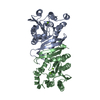 7l0aC 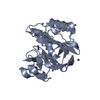 2zwrS S: Starting model for refinement C: citing same article ( |
|---|---|
| Similar structure data |
- Links
Links
- Assembly
Assembly
| Deposited unit | 
| ||||||||
|---|---|---|---|---|---|---|---|---|---|
| 1 | 
| ||||||||
| 2 | 
| ||||||||
| 3 | 
| ||||||||
| 4 | 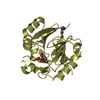
| ||||||||
| Unit cell |
|
- Components
Components
| #1: Protein | Mass: 23735.238 Da / Num. of mol.: 4 Source method: isolated from a genetically manipulated source Source: (gene. exp.)   References: UniProt: W8UAH2, UniProt: A0A0D1GCF8*PLUS, hydroxyacylglutathione hydrolase, Hydrolases #2: Chemical | ChemComp-ZN / #3: Chemical | ChemComp-SO4 / #4: Water | ChemComp-HOH / | Has ligand of interest | N | Has protein modification | Y | |
|---|
-Experimental details
-Experiment
| Experiment | Method:  X-RAY DIFFRACTION / Number of used crystals: 1 X-RAY DIFFRACTION / Number of used crystals: 1 |
|---|
- Sample preparation
Sample preparation
| Crystal | Density Matthews: 2.3 Å3/Da / Density % sol: 46.6 % |
|---|---|
| Crystal grow | Temperature: 289 K / Method: vapor diffusion, hanging drop / pH: 6.9 Details: 2 uL hanging drops containing a 1:1 mixture of protein (8 mg/mL) and crystallization buffer (0.1 M imidazole pH 6.9, 0.2 M ammonium sulfate, 0.1 M calcium chloride, and 21% PEG 8k) |
-Data collection
| Diffraction | Mean temperature: 100 K / Serial crystal experiment: N |
|---|---|
| Diffraction source | Source:  SYNCHROTRON / Site: SYNCHROTRON / Site:  APS APS  / Beamline: 19-ID / Wavelength: 1 Å / Beamline: 19-ID / Wavelength: 1 Å |
| Detector | Type: DECTRIS PILATUS3 6M / Detector: PIXEL / Date: Jul 30, 2020 |
| Radiation | Protocol: SINGLE WAVELENGTH / Monochromatic (M) / Laue (L): M / Scattering type: x-ray |
| Radiation wavelength | Wavelength: 1 Å / Relative weight: 1 |
| Reflection | Resolution: 1.65→50 Å / Num. obs: 195660 / % possible obs: 98.4 % / Redundancy: 5.5 % / Rmerge(I) obs: 0.108 / Rpim(I) all: 0.05 / Rrim(I) all: 0.119 / Χ2: 1.072 / Net I/σ(I): 4.8 / Num. measured all: 537795 |
| Reflection shell | Resolution: 1.68→1.71 Å / Redundancy: 4.4 % / Rmerge(I) obs: 0.939 / Num. unique obs: 5122 / CC1/2: 0.993 / Rpim(I) all: 0.041 / Rrim(I) all: 0.098 / Χ2: 2.994 / % possible all: 88.7 |
-Phasing
| Phasing | Method:  molecular replacement molecular replacement |
|---|
- Processing
Processing
| Software |
| |||||||||||||||||||||||||||||||||||||||||||||||||||||||||||||||||||||||||||||||||||||||||||||||||||||||||||||||||||||||||||||||||||||||||||||||||||||||||||||||||||||||||||||||||||||||||||||||||||||||||||||||||||||||||
|---|---|---|---|---|---|---|---|---|---|---|---|---|---|---|---|---|---|---|---|---|---|---|---|---|---|---|---|---|---|---|---|---|---|---|---|---|---|---|---|---|---|---|---|---|---|---|---|---|---|---|---|---|---|---|---|---|---|---|---|---|---|---|---|---|---|---|---|---|---|---|---|---|---|---|---|---|---|---|---|---|---|---|---|---|---|---|---|---|---|---|---|---|---|---|---|---|---|---|---|---|---|---|---|---|---|---|---|---|---|---|---|---|---|---|---|---|---|---|---|---|---|---|---|---|---|---|---|---|---|---|---|---|---|---|---|---|---|---|---|---|---|---|---|---|---|---|---|---|---|---|---|---|---|---|---|---|---|---|---|---|---|---|---|---|---|---|---|---|---|---|---|---|---|---|---|---|---|---|---|---|---|---|---|---|---|---|---|---|---|---|---|---|---|---|---|---|---|---|---|---|---|---|---|---|---|---|---|---|---|---|---|---|---|---|---|---|---|---|
| Refinement | Method to determine structure:  MOLECULAR REPLACEMENT MOLECULAR REPLACEMENTStarting model: 2ZWR Resolution: 1.65→47.96 Å / SU ML: 0.24 / Cross valid method: THROUGHOUT / σ(F): 1.34 / Phase error: 35.83 / Stereochemistry target values: ML
| |||||||||||||||||||||||||||||||||||||||||||||||||||||||||||||||||||||||||||||||||||||||||||||||||||||||||||||||||||||||||||||||||||||||||||||||||||||||||||||||||||||||||||||||||||||||||||||||||||||||||||||||||||||||||
| Solvent computation | Shrinkage radii: 0.9 Å / VDW probe radii: 1.11 Å / Solvent model: FLAT BULK SOLVENT MODEL | |||||||||||||||||||||||||||||||||||||||||||||||||||||||||||||||||||||||||||||||||||||||||||||||||||||||||||||||||||||||||||||||||||||||||||||||||||||||||||||||||||||||||||||||||||||||||||||||||||||||||||||||||||||||||
| Displacement parameters | Biso max: 100.31 Å2 / Biso mean: 39.65 Å2 / Biso min: 17.6 Å2 | |||||||||||||||||||||||||||||||||||||||||||||||||||||||||||||||||||||||||||||||||||||||||||||||||||||||||||||||||||||||||||||||||||||||||||||||||||||||||||||||||||||||||||||||||||||||||||||||||||||||||||||||||||||||||
| Refinement step | Cycle: final / Resolution: 1.65→47.96 Å
| |||||||||||||||||||||||||||||||||||||||||||||||||||||||||||||||||||||||||||||||||||||||||||||||||||||||||||||||||||||||||||||||||||||||||||||||||||||||||||||||||||||||||||||||||||||||||||||||||||||||||||||||||||||||||
| LS refinement shell | Refine-ID: X-RAY DIFFRACTION / Rfactor Rfree error: 0 / Total num. of bins used: 30
|
 Movie
Movie Controller
Controller


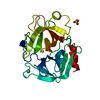

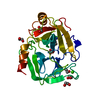
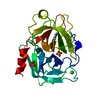


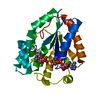
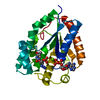
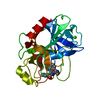
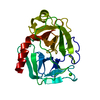
 PDBj
PDBj






